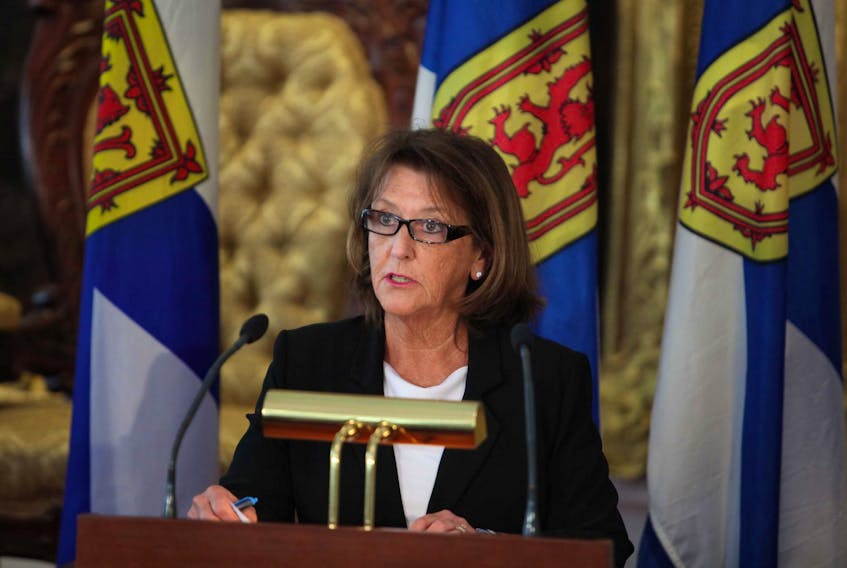Despite shelling out $48 million to clean up two abandoned gold mines, the province boasts a bonus surplus of $90 million more than expected for the 2018-19 fiscal year.
“The audited financial statements show a net positive position of $120 million,” Finance Minister Karen Casey said Thursday about the audited statement that compares the financial reality of what happened in the past fiscal year, which ended in March, with what was forecast in the budget.
That final surplus of $120 million is $90.6 million higher than the budget estimate of $29.4 million. Consolidated revenue was up $101.9 million from the budget to $11.87 billion, mainly due to changes in revenue from petroleum royalties, provincial recoveries and federal equalization.
The mine remediation funds will go to clean up the former Montague gold mine near Dartmouth and the Goldenville mine, near Sherbrooke.
“There are abandoned sites, some are contaminated and some are not,” Casey said of a review that identifies potential remediation sites. “We want to make sure that, in particular if they were close to communities or close to water sources, that we have an assessment to determine which ones they are and the intensity of the contamination that’s there.”
The two mines, worked as far back as the 1860s, are contaminated with arsenic and mercury deposits. Casey said she could not estimate how much it will cost to remediate all abandoned sites that are deemed to require it after government assessment.
Casey reported that provincial expenses overall were up $11.3 million to $11.75 billion, mainly due to an increase in demand for health-care services and increased funding for the remediation of Boat Harbour and Harrietsfield in Halifax Regional Municipality and the abandoned mines.
The Boat Harbour site, which has been treating effluent from the nearby Northern Pulp mill in Pictou County for more than 50 years, has a $230-million remediation price tag right now, $35.4 million more than the projected accrual cost for the past budget. The $230-million tab is expected to increase but Casey said she can’t estimate what the final remediation cost will be.
The Transportation and Infrastructure Renewal Department came in with expenses that were $73.4 million more than forecast, including the additional Boat Harbour expense, $7.8 million for increased snow and ice removal and $13.1 million for the Nova Scotia to Maine ferry that included $8.5 million for relocating the American terminal to Bar Harbor.
The Energy and Mines Department expenses were $10.6 million more than projected and the Education Department came in $9.3 million above budget. The Agriculture Department expenses were $9.6 million more than projected, primarily due to a $10.1-million increase in the Frost Loss program to help farmers.
Casey said the government will continue to focus on fiscal sustainability, economic growth and Nova Scotians’ priorities. Casey said the province has its highest-ever population, a greater number of young people staying in or returning to the province and had more full-time jobs in 2018 than at any other point in the province’s history.
“Budget 2018-19 strengthened services and supports for Nova Scotians and key investments in health care, education, early years, communities and the economy,” Casey said. “We made strategic investments while remaining fiscally responsible and this approach helped us respond to increased demand for services and unexpected expenses, such as assisting farmers impacted by frost and increased demands on health care.”
The government also paid out $377.8 million to public servants who chose the option for a one-time lump sum payment in place of the Public Service Award. In 2015, government announced its intention to phase out the Public Service Award, an allowance given on retirement and committed to honouring service amounts accumulated up to that point.
NDP Leader Gary Burrill said everything was not as positive as the finance minister would have people believe.
“The tone of what she had to say was so entirely self-congratulatory for the government,” Burrill said of Casey’s news conference. “Here she is, the minister of finance for the province that has the lowest median income in the country and the only province in the country where child poverty is getting worse. It seems to me that this self-satisfied tone is entirely out of place and it suggests that they are turning their eyes away from the realities of a great many people’s lives.
“It would be much more economically sensible and responsible on their part to acknowledge in a deep way that there are very significant numbers in our province for whom this is a time of abject, urgent financial struggle. But there is not a single word of even the slightest recognition that this is the case.”
At fiscal year’s end, net debt was $15.01 billion. The net debt to gross domestic product (GDP) ratio for 2018-19 was 34.1 per cent, down one percentage point from 2017-18. The net debt to GDP ratio has declined 3.7 percentage points since 2015.









